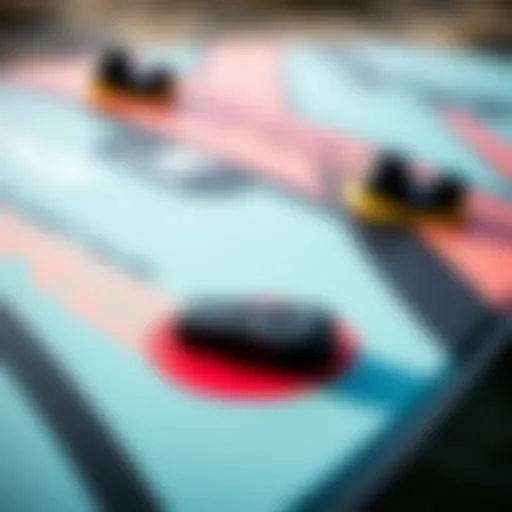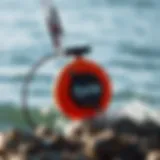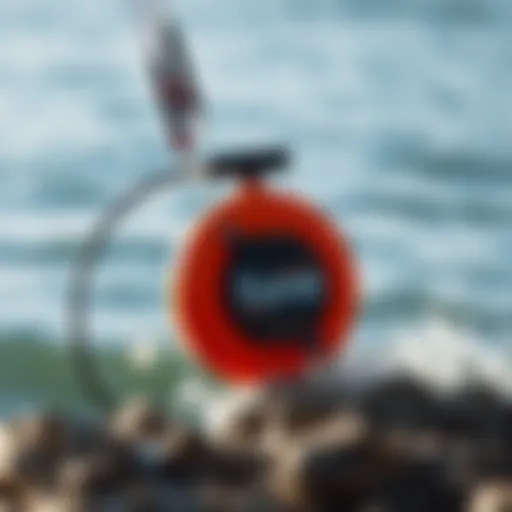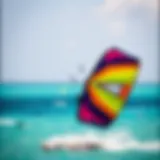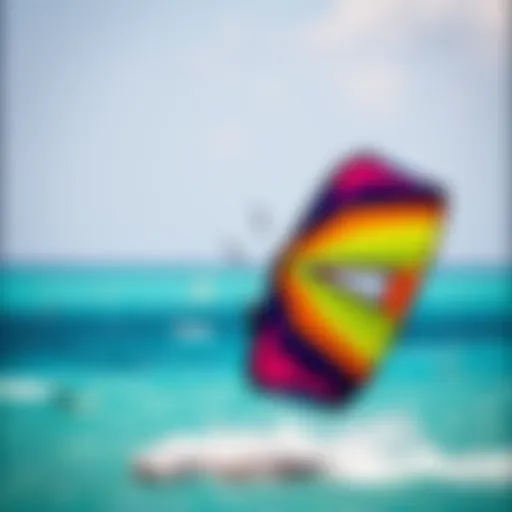Dynamics of Fly Efoiling: Mechanics and Benefits


Intro
Fly efoiling is catching the attention of water sports enthusiasts. This sport combines the thrill of surfing with the technology of hydrofoils, allowing riders to skim above the water, using the power of the wind. Kiteboarders, in particular, are discovering new ways to elevate their experience through this innovation. The mechanics behind fly efoiling are intricate, yet the potential it offers is immense.
With its growing popularity, it's important to understand what makes fly efoiling tick, its benefits, and how it can transform one's approach to kiteboarding. This guide will take a deep dive into its various aspects—ranging from gear insights to essential techniques—for both the novice and seasoned rider. Expect to learn not only about the technical specs but also personal anecdotes and user experiences that will illuminate your understanding of this fascinating domain.
Let’s kick off our exploration by examining the gear you need for fly efoiling, a critical foundation for anyone looking to make a splash in this exciting sport.
Preamble to Fly Efoiling
The world of water sports is always evolving, and fly efoiling stands at the forefront of that evolution. This sport combines technology and thrill, offering enthusiasts a unique way to experience the water. With its rise in popularity, understanding the essence of fly efoiling becomes crucial, not just for those keen on trying it out, but also for the seasoned kiteboarders looking to enrich their skills on the water.
Definition and Concept
At its core, fly efoiling is a fusion of traditional kiteboarding and advanced hydrofoil technology. Imagine riding a board that glides above the water's surface, powered by a battery-operated motor and lifting through the use of foils. This setup creates an experience that’s both exhilarating and serene.
In essence, fly efoiling allows riders to soar above the waves, feeling the rush of adrenaline while simultaneously enjoying a quiet, almost ethereal ride. The concept is built on the principle of lift, where a hydrofoil submerged underwater drastically reduces drag and enables the board to rise, creating a floating effect. This not only enhances performance but also makes it more adaptable to various water conditions.
Evolution of Efoiling Technology
Fly efoiling didn’t spring from nothing; it has a background rooted in both kiteboarding and windsurfing technologies. Early iterations began to appear in the mid-2010s, as innovators sought to merge kiteboarding's thrill with the simplicity and accessibility of small watercraft. Initially, these boards were rudimentary, often requiring a significant degree of skill to master.
Fast forward to today, and the technological advancements are nothing short of remarkable. Now, fly efoils come equipped with durable materials, improved battery life, and sophisticated control systems designed for both beginners and experts alike. The electric motor technology has evolved, offering more power and longer ride times, while smart designs enhance stability.
In a nutshell, the evolution of efoiling reflects a shift towards more user-friendly, efficient mechanics that appeal not just to hardcore adventurers but to casual water enthusiasts as well. With every advancement, it broadens the horizon for what kiteboarding can be, keeping it alive and exciting.
"As technology advances, the barrier to entry diminishes, allowing more people to experience the thrill of fly efoiling."
In summary, fly efoiling's significance lies not just in its thrilling experience but also in its potential to redefine water sports. By bridging the gap between innovation and adventure, it sets the stage for an exhilarating future on the water.
Understanding the Mechanics
Understanding the mechanics of fly efoiling is crucial for anyone looking to fully appreciate this innovative sport. At the heart of every thrilling ride on the water are the intricate components and systems that work together seamlessly. By diving into the mechanics, kiteboarders and adventurers gain insight into how to maximize performance and enhance their experience. The mechanics reveal not only how lift is generated to elevate riders above the water but also how they can control their movements with precision. It’s these technicalities that set fly efoiling apart from traditional options.
Components of a Fly Efoil
A fly efoil comprises several integral components, each playing a distinct role. Understanding these components is vital for anyone who wants to get into the sport.
- Board: The board is typically made from lightweight materials, allowing for easy maneuverability. It’s designed to help the rider balance while gliding.
- Foil: This piece is usually the star of the show. It consists of a front wing and a rear stabilizer, both carefully crafted to generate lift effectively when in motion.
- Motor: Positioned on the mast, the motor is responsible for propulsion. Different motors can affect speed and battery life.
- Battery: A high-capacity battery provides the necessary power, making the experience of fly efoiling not just thrilling but accessible for longer periods.
- Mast: This connects the board to the foil and must be robust yet lightweight to withstand tension and turbulence on the water.
Understanding the purpose and function of each component allows riders to make informed decisions when purchasing or maintaining their equipment. A rider well-versed in their gear is one who steps onto the water with confidence.
How Lift is Generated
Lift is the magic sauce behind how a fly efoil elevates a rider above the water. Unlike traditional surfing or kiteboarding, where buoyancy plays a significant role, efoiling operates on the principle of hydrodynamics. When a rider accelerates, the foil moves through the water, creating variations in pressure above and below the wing.
The key elements in generating lift include:
- Angle of Attack: Adjusting this angle can significantly influence the lift. As the angle increases, so does lift, up to a point before drag overtakes the benefits.
- Speed: Achieving the optimum speed is essential. The faster you go, the more lift is generated. Understanding how speed interacts with water dynamics can improve riding performance.
- Wing Design: The shape and size of the wing influence lift as well. Larger wings yield more lift at lower speeds, which is beneficial for beginners.
The beauty of efoiling lies in mastering these aspects, enabling riders to enjoy smooth, floating rides above the water. A deeper understanding of lift helps individuals fine-tune their technique, making every session not just thrilling but also more efficient.
Control and Steering Mechanisms
Steering a fly efoil requires not just skill but also a solid grasp of its control mechanisms. Unlike traditional methods, controlling an efoil entails an interplay between balancing body weight and operating the electric controls.
- Weight Shift: By shifting weight forward or backward, riders can influence the angle of the board, which affects lift and direction. Leaning forward increases speed and lift, while leaning back can help with stability.
- Handheld Remote: Most efoils come with a wireless remote that controls the speed of the motor. Fine-tuning speed through the remote is crucial; overaccelerating can lead to loss of control.
- Foil Angle: By understanding how the foil's angle affects the ride, skilled riders can execute sharp turns and smooth transitions, enhancing their overall experience.
"Mastering control in fly efoiling is not just about steering; it's about harmonizing the body, technology, and water."
The combined understanding of weight distribution, remote control management, and foil angle is what distinguishes novice riders from seasoned efoilers. Knowing how to manipulate these variables leads to exhilarating dives and effortlessly smooth glides through the water.
Benefits of Fly Efoiling
The concept of fly efoiling transcends mere adventure; it represents a remarkable fusion of technology, freedom, and environmental consciousness on water. For both seasoned enthusiasts and curious newcomers, understanding the key benefits of fly efoiling is crucial, as it enriches the overall experience of water sports. Each benefit unfolds a new layer of appreciation for kiteboarders, instructors, travelers, and hobbyists alike, providing insights into why this innovation is carving a niche in the aquatic world.
Enhanced Freedom on Water
When one thinks of freedom on the water, fly efoiling stands out as an exhilarating option. Unlike traditional water sports that often require specific wind conditions, fly efoiling allows users to glide over the waves with minimal reliance on wind. This technology enables kiteboarders to explore hidden coves, serene lakes, or expansive ocean blue without constraints. The sensation of uplift and the ability to venture far from shore can change the entire game.
Imagine finding a secluded spot where the water is calm, illuminating a feeling of weightlessness beneath you. With a fly efoil, you can carve turns with smooth elegance, navigating your own path without the hindrance of conventional sails or kites. As you take off, the electric propulsion system brings forth another dimension of spontaneity to the watercraft. No longer does one have to wait endlessly for the gusts to pick up; you simply steady yourself on the board and embark on your journey.


Environmental Considerations
In the age of ecological awareness, the environmental impact of recreational activities weighs heavily on enthusiasts. Fly efoiling emerges as a greener alternative within the spectrum of water sports. Most efoils are powered by advanced batteries, reducing the reliance on fuel or even traditional wind-driven sails. This transition toward electric propulsion takes a step away from practices that might harm fragile aquatic ecosystems.
The whispers of electric motors are considerably quieter than the roar of gas engines, minimizing disruption to marine life. Additionally, many manufacturers are dedicated to creating sustainable materials that are less harmful to the environment. This eco-conscious mindset not only aligns with the shifting preferences of today’s recreation seekers but enables riders to leave behind a smaller carbon footprint while they chase the thrill of flying above the water's surface.
As recreationalists, the move to fly efoiling illustrates a proactive stance in protecting what we cherish - the waterways and their surrounding environments.
Physical and Mental Benefits
Engaging in fly efoiling also brings an array of physical and mental advantages that enhance overall well-being. Balancing on the board and navigating the water demands strong core muscles, improving stability and coordination. The full-body workout is invigorating, as it engages leg, arm, and back muscles while providing an adrenaline boost that invigorates both body and mind.
Moreover, the mental benefits are notable. The act of gliding above the water, feeling the fresh air against your skin, heightens one's sense of mindfulness, offering a reprieve from the chaos of daily life. It bridges the gap between the individual and nature, fostering a connection that is both calming and exhilarating. The thrill of mastering fly efoiling techniques contributes to a sense of accomplishment, adding to one's confidence and life satisfaction.
Fly Efoiling vs. Traditional Kiteboarding
The realm of water sports often finds itself navigating through innovations that redefine the experience of enthusiasts. Fly efoiling and traditional kiteboarding are two prominent activities that represent distinct approaches to riding the waves. Understanding the nuances of both offers a fertile ground for enthusiasts to determine what best suits their style and skill set. This section digs deeper into this comparative analysis, highlighting the performance, learning curves, and a variety of other essential elements that define these two thrilling sports.
Performance Comparison
When it comes to performance, fly efoiling and traditional kiteboarding present markedly different experiences.
Speed and Agility
Fly efoiling often provides a unique edge in terms of speed. As the hydrofoil lifts the board above the water's surface, it significantly reduces drag, allowing riders to achieve impressive velocities with minimal effort. Enthusiasts have reported speeds reaching upwards of 30 knots, making it a thrilling choice for high-speed lovers. On the flip side, traditional kiteboarding allows for exhilarating jumps and tricks, which many riders favor for sheer spectacle.
Maneuverability
Fly efoiling excels in smooth, flowing movements. Riders can carve turns in a way that feels almost effortless while being elevated above the water. Traditional kiteboarding, however, is unmatched when it comes to aerial tricks and jumps. Kiteboarders can use wind power for spectacular stunts that carve their place in competitions.
Wind Conditions
Fly efoiling requires less consistent wind conditions, which can be a significant plus for places where breezes fluctuate. Kiteboarders, in contrast, depend heavily on steady winds to maximize performance and ensure safe landings after jumps. The advantage here can influence which discipline is preferable depending on local weather patterns.
"Although fly efoiling brings a futuristic twist to water sports, traditional kiteboarding holds its own with tried-and-true thrill."
Learning Curve and Skill Development
Learning any water sport comes with its challenges, and the same holds true for both fly efoiling and traditional kiteboarding. The trajectory of skill development can vary greatly between these two activities.
Time Investment
For many newcomers, efoiling may initially seem more approachable. The hydrofoil's lift eliminates many obstacles associated with traditional kiteboarding, like managing the power of the kite against surf and waves. Consequently, some find that they can start gliding above the water more quickly, often within a few sessions of practice.
However, traditional kiteboarding introduces an essential understanding of wind dynamics and kite control that can be invaluable. Riders often must spend a longer time honing their kite-flying skills, especially to perform advanced maneuvers like jumps and spins. Those who tackle this challenge usually develop deeper insights into wind behavior that can be beneficial for any water sport.
Physical Requirements
Physical demands can also differ. Fly efoiling focuses more on balance and core strength, whilst traditional kiteboarding typically requires more upper body strength to control the kite and manage the board during maneuvers.
In summary, while both sports have unique learning curves and physical requirements, the preferences often differ based on individual skill sets and aspirations. Riders may find joy in the quick satisfaction that fly efoiling offers, or relish the depth and complexity that traditional kiteboarding demands.
The mix of acumen, technique, and sheer enjoyment makes both water sports distinctly appealing, which only underscores the ongoing relevance of this comparison in navigating today’s exciting world of watersports.
For more information on kiteboarding and efoiling community dynamics, check resources like Wikipedia, Britannica, and Reddit's Kiteboarding Community.
Safety and Regulations
When it comes to fly efoiling, prioritizing safety and understanding necessary regulations are fundamental aspects that determine not only an individual's enjoyment but also their well-being on the water. Since this activity involves high speeds and surfacing above water, it's essential to be well-informed and prepared for potential hazards. This section will explain why safety gear and legal considerations are vital for optimal fly efoiling experiences.
Personal Safety Gear
Before you even think about heading out on the water with your fly efoil, taking a moment to gear up properly is non-negotiable. Personal safety gear can make a world of difference. Here’s a quick rundown:
- Life Jacket: This is the golden rule. A buoyant life jacket can keep you afloat if you take an unexpected dunk. Choose one that’s specifically designed for watersports, as these often provide better mobility.
- Helmet: A hard-shell helmet protects your noggin from potential mishaps, especially during those daring dives or crashes.
- Impact Vest: This isn’t just about style; an impact vest cushions your body against hard falls, ensuring you walk away with just the bruises to your ego.
- Wetsuit: Beyond warmth in chilly waters, a wetsuit provides another layer of protection against abrasions and jellyfish stings.
It’s like being wrapped in a security blanket while you sail through the waves, reducing the risks associated with this thrilling sport. So what’s the bottom line? Taking time to put on the proper gear ensures your efoiling adventures remain exhilarating, yet safe.
Legal Considerations
Navigating the waters goes beyond just riding the waves; it involves understanding the legal landscape regarding fly efoiling. Safety regulations may vary widely depending on location, so doing your homework is crucial.
- Local Laws: Every country, and often state or municipality, can have its specific regulations regarding fly efoiling. Some areas might restrict certain activities or the kind of equipment used, ensuring users prioritize safety. Always check the local laws before heading out, be it on a beach or a lake.
- Registration and Insurance: In some regions, you may need to register your equipment or have liability insurance in case of accidents. If you're not protected, a single misstep could lead to a hefty financial burden.
- Environmental Guidelines: Fly efoiling can also impact local wildlife. Stay informed about protected areas and avoid disturbing habitats. Equally, there are some spots that allow efoiling but only under strict guidelines to safeguard marine life.
"Ignorance of the law excuses no one." This legal adage rings particularly true in adventure sports where the repercussions can be significant. Knowing the regulations helps avoid unnecessary fines and enhances the responsible enjoyment of the sport.
By ensuring you are equipped with proper safety measures and are informed about the legalities at hand, you set the stage for a safer and more enjoyable efoiling adventure.
Being a responsible flyer on the waters not only protects you but also ensures that the community continues to thrive without restrictions.
For more information on safety and regulations, consult relevant local governmental resources such as *.gov or organizations like the Royal Yatching Association rya.org.uk.
Stay safe and happy efoiling!
Maintenance and Care


Maintaining your fly efoil is just as critical as mastering the art of flying above the water. Regular upkeep can significantly extend the lifespan of your equipment and ensure that every ride is thrilling yet safe. From inspection routines to cleaning habits, being meticulous about maintenance enhances performance and keeps unexpected hiccups at bay.
Routine Checks and Cleaning
Routine checks are the bedrock of maintenance. It’s not enough to just hop on your fly efoil and take to the skies. You must make it a practice to carry out thorough inspections regularly. Here’s a list of what to watch for:
- Battery Health: Check for any signs of wear, corrosion, or damage. Keeping your battery in top shape is crucial for sustaining longer flights. Make sure the connectors are clean and free of debris.
- Hull Integrity: Look for scratches or cracks in the board's hull. Any damage could compromise its buoyancy and lead to serious consequences while floating.
- Foil Condition: Inspect the foil for dings or dents. A warped foil will not only affect lift but also your overall stability.
- Wires and Connections: Take a moment to ensure all electrical connections are secure. Loose wires can lead to failures during your ride, and that is the last thing you want to encounter midair.
Cleaning is another easy yet often overlooked task. Saltwater and sand can take a toll on the electrical components and the board itself. To clean your efoil:
- Rinse Thoroughly: After each ride, give your board a good rinse with fresh water. This helps remove salt and debris.
- Dry Completely: Moisture can lead to rust. Use a soft, absorbent cloth to dry off your equipment, paying extra attention to electrical connections.
- Remove the Prop Thruster: If possible, detach any removable parts to clean and inspect them individually. This ensures you do not miss dirt buildup that could affect performance.
- Store Properly: Ensure your fly efoil is stored in a climate-controlled environment. Avoid leaving it exposed to direct sunlight or moisture for extended periods.
Regular maintenance not only boosts performance but also enhances your safety on water, extending the lifespan of your fly efoil while ensuring many exhilarating rides ahead.
Troubleshooting Common Issues
Despite all precautions, issues can arise. Knowing how to troubleshoot common problems can save you time and frustration. Here’s how you can handle a few frequent issues:
- Power Loss: If your efoil suddenly loses power, double-check the battery level. It may be running low or improperly connected. Sometimes a deep clean and ensuring that connections are tight can resolve the issue.
- No Lift: A lack of lift could stem from an improperly configured foil or weight distribution on the board. Adjust your stance and test if repositioning helps. Ensure the foil is assembled correctly and is free from damage.
- Steering Problems: If you find it hard to control your efoil, inspect the steering mechanism and make sure everything is functioning smoothly. It can also help to check if the fins are aligned correctly.
- Strange Noises: Unusual sounds often signal something is amiss. If you hear grinding or rattling noises, don’t ignore them. Check the components, and it may be wise to consult with a professional before further riding.
In summary, caring for your fly efoil isn't merely about aesthetics; it's a matter of safety and enhanced performance. Regular checks, proper cleaning, and troubleshooting in a methodical way will ensure your adventures remain as enthralling and trouble-free as possible.
Exploring Flight Techniques
When it comes to fly efoiling, the ability to effectively start, maneuver, and land is akin to mastering the foundations of a new art form. These flight techniques not only enhance the overall experience but also ensure safety and confidence on the water. Understanding these intricacies can significantly elevate one’s performance and enjoyment, making it a crucial aspect for anyone who wishes to delve deeper into this exhilarating sport.
Starting and Landing Efficiently
Efficient starting and landing can often mean the difference between a fluid ride and an awkward misadventure.
Starting off involves a few key steps:
- Choosing the Right Location: Look for calm waters without strong currents or too much wind. Getting in the right spot helps immensely.
- Proper Body Position: Lean slightly forward while keeping your knees bent helps maintain balance. Your weight should be evenly distributed between the board and the mast.
- Throttle Control: Gradually increase the throttle instead of slamming it down. This gradual acceleration helps in achieving lift smoothly.
"A smooth start is like a gentle wave; it sets the tone for the entire ride."
Landing requires equal finesse. Key considerations include:
- Approaching the Shore: Don’t rush; slow down as you get near your intended landing spot to avoid mishaps.
- Positioning the Foil: Ensure your foil remains level to prevent a hard impact. A level approach allows for a softer landing.
- Dismounting Wisely: As you touch down, step off the board gently, keeping your focus on maintaining your balance.
By understanding these starting and landing techniques, one can navigate smoothly, even in less than ideal conditions.
Advanced Maneuvers and Tricks
Once you feel comfortable with the basics, it’s time to spice things up with advanced maneuvers and tricks. These will test your skills and take your fly efoiling experience to another level.
- Carving: Shifting your weight from heel to toe creates beautiful arcs in the water. Practice elevating the foil during these turns for added excitement.
- Jumping: This one’s the cherry on top! Timing your jump during a wave’s crest while maintaining proper foil speed is crucial.
- 360s and Spins: Combining jumping with a quick rotation adds flair to your ride. Ensure you have a solid grip and control of your speed.
The thrill of learning how to perform these tricks expands one's repertoire and enhances the overall enjoyment of fly efoiling. Not only does it push the envelope of what's possible on the water, but it also offers a chance for self-expression.
In summary, mastering flight techniques — from starting to landing, and then progressing to complex maneuvers — is essential for anyone looking to fully embrace the fly efoiling experience. With practice and patience, these techniques can transform your time on the water from merely fun to exceptionally exhilarating.
Gear Recommendations
Selecting the right gear for fly efoiling is paramount. This does not merely hinge on preference but significantly impacts the overall experience, performance, and safety of the activity. With various elements to ponder, from the efoil itself to the accessories that complement your setup, this section aims to cut through the noise and guide you in making suitable choices.
Selecting the Right Efoil
When it comes to choosing an efoil, understanding the core dimensions of your needs is vital. Not all efoils are cut from the same cloth; they vary in size, weight, power, and design. Here are several key considerations:
- Weight Capacity: It is essential to assess how much weight the efoil can support. Each efoil comes with distinct specifications, so knowing your weight or any additional gear you plan to carry is crucial.
- Board Size and Shape: Smaller boards work well for seasoned riders looking for speed and maneuverability. In contrast, wider boards provide stability, ideal for beginners or those wishing to cruise leisurely.
- Motor Power: The thrust and effort necessary to lift you out of the water are influenced by the motor's power. A more potent motor can give better performance, especially for heavier riders or those looking to execute advanced tricks.
- Battery Life: Pay attention to how long the battery lasts on a single charge. If you're aiming for extended joyrides or simply wish to avoid constant recharging, a model with a long-lasting battery should be high on your list.
- Brand Reputation: Brands like LiftFoil and Fliteboard have gained traction for their reliability and innovation. Reviews and community feedback can play a crucial role in your selection process, showing you what truly stands up to the test of water.
Choosing the right efoil isn't just about picking the flashiest model; it involves serious thought about your skill level, riding style, and the type of waters you'll be exploring. Informing yourself about these factors can set the stage for endless adventures.
Accessories for Optimal Performance
While the efoil itself is the star of the show, accessories can make or break your experience. Investing in proper accessories can enhance performance and comfort level, leading to safer and more enjoyable rides. Consider the following:
- Safety Gear: This includes what every efoiler must prioritize. A good quality life jacket, helmet, and possibly impact vests should form a core part of your gear. Safety comes first, especially in dynamic water environments.
- Wetsuits: Depending on the climate, opting for a wetsuit can improve your experience. It adds comfort and warmth, especially in cooler waters, and can also protect against cuts or scrapes.
- Foot Straps: Ensuring your feet are firmly attached to the board can help greatly with control and reduce the risk of falls, particularly during high-speed maneuvers.
- Repair Kits: An emergency repair kit that includes essentials like duct tape and tools can be a lifesaver, enabling quick fixes on the go. It is wise to carry one since accidents can happen even to the best of us.
- Transport Bags: A specialized bag or case to transport your efoil can protect it from damage during travel. Look for padded options that fit your model snugly.
In summary, the right gear and accessories not only enhance performance but also ensure you're safe and comfortable while engaging in this exhilarating activity. Investing properly will pay dividends in both enjoyment and peace of mind on the water.
"The joy of fly efoiling is not just in the flight, but in the preparation and gear that elevates the entire experience."


For more detailed tips, check out wikihow.com or the efoiling community on reddit.com.
Locations for Fly Efoiling
In the thrilling world of fly efoiling, location plays a pivotal role. The right spot not only enhances the experience but also significantly influences the safety and performance of the ride. Selecting a good location can mean the difference between a delightful adventure over the water or a frustrating challenge. The ideal sites showcase calm waters, consistent winds, and appropriate depth, allowing efoilers to make the most of their high-flying outings.
When it comes to the exploration of locations, there are several elements worth considering:
- Accessibility: Easy access to the water can make a huge difference, especially for those not looking to haul heavy gear.
- Crowd Levels: Some may prefer the serene solitude of less frequented spots, while others thrive in the buzz of a busy beach.
- Cost: Some destinations can demand a pretty penny just to get on the water, while others might offer free access or low entry fees.
- Local Regulations: Understanding the rules of the area helps avoid any unforeseen issues.
These factors shape the choice of where to fly efoil, and can provide insight into the community aspect as well. Efoilers often connect with fellow enthusiasts at popular spots, gaining tips and sharing experiences.
Top Destinations Worldwide
Across the globe, there are incredible locations for efoiling that cater to both newbies and veterans. A few noteworthy spots include:
- Maui, Hawaii: Renowned for its stunning landscapes and excellent wind conditions, Maui offers unparalleled efoiling experiences with warm waters and breathtaking views.
- Lake Como, Italy: With its unique combination of mountains and lakes, this picturesque setting provides thrilling rides against a stunning backdrop.
- Cabo San Lucas, Mexico: Known for its vibrant marine life and beautiful coastlines, Cabo's waters create an exhilarating environment.
- Gold Coast, Australia: This hotspot is a magnet for water sports, boasting consistent waves and ideal conditions.
Each spot presents unique features that could well enhance one's fly efoiling journey.
Weather Considerations and Conditions
When planning a fly efoiling outing, it’s essential to keep an eye on the weather. Conditions can shift rapidly, altering safety and performance. Key weather elements to consider include:
- Wind Speed and Direction: Ideal wind conditions generally range between 10 to 25 knots. Constant winds that aren't gusty will offer a smoother experience.
- Wave Height: Efoiling thrives in calmer waters, so checking for wave height can assure a more controlled ride.
- Temperature: Comfortable temperatures contribute to a better efoiling session. Gear appropriately for colder waters to avoid discomfort.
"Weather can be unpredictable; always check forecasts before heading out on your efoil. This helps you stay as safe as a cat on a hot tin roof."
Riding a fly efoil in the wrong conditions could easily turn into a harrowing experience. Hence, diligent attention to the weather forecast is paramount for a successful excursion.
Community and Culture
The realm of fly efoiling is not just about the machines that glide above the water; it’s also deeply rooted in a vibrant community and evolving culture. Engaging with others who share this passion can not only enhance the efoiling experience but also foster a sense of camaraderie that transcends geographical boundaries. Important aspects of this community stem from connection, knowledge-sharing, and mutual support, irrespective of skill level.
Connecting with Fellow Efoilers
Finding like-minded enthusiasts who share the joys and challenges of fly efoiling can be incredibly rewarding. Many efoilers find that the connections made within this community can lead to lifelong friendships. Social media platforms, especially forums like Reddit, as well as specialized Facebook groups, serve as melting pots for riders to swap tips, tricks, and personal stories.
Additionally, local clubs and efoiling meetups are springing up in various regions, where enthusiasts gather to share experiences on the water. These gatherings not only inspire those who are just starting out but also provide opportunities for advanced riders to showcase their skills. Engaging in discussions at these meetups often yields advice on
- gear selection,
- perfecting techniques, and
- discovering new locations ideal for efoiling.
The warmth of community can soften the learning curve; newcomers often find mentors or peers willing to give guidance as they rise above the waves. Conversations often revolve around individual experiences, troubleshooting gear issues, or even sharing videos of outstanding performances.
"The best moments in life are often shared with those who chase the same winds."
Events and Competitions
As the fly efoiling community develops, events and competitions have started to gain traction. These are not merely contests; they are expressions of creativity, skill, and sportsmanship. From local competitions to international championships, efoiling events provide a platform for riders to showcase their talent while also allowing the community to come together, celebrate, and learn.
Competing can be exhilarating, yet there's a wholesome atmosphere that encourages skill development. Riders push their limits, not just to win but to learn from one another. Often, spectators can also engage by participating in workshops and demonstrations, fostering an inclusive environment.
Here are some notable events and their benefits:
- Lessons in Technique: While watching skilled efoilers, attendees often pick up useful techniques and tips through observation.
- Networking Opportunities: Competitions draw participants from diverse locations, providing an excellent chance to network and build friendships.
- Showcase of Innovations: These events frequently unveil the latest technological advancements in efoiling gear, giving attendees a glimpse into the future of the sport.
In essence, the community and culture surrounding fly efoiling not only enhances personal enjoyment but also contributes significantly to the evolution of the sport. For those considering stepping into this world, connecting with others can serve as both a motivator and a resource for improvement, ensuring that the journey is as thrilling as the ride itself.
Future of Fly Efoiling
The future of fly efoiling is shaping up to be as intriguing as the sport itself. As technology evolves and the appetite for thrilling water sports grows, fly efoiling stands at the cusp of revolution. There's a swirling mix of innovation, sustainability, and accessibility at play, making it a pivotal area of interest for many water sports enthusiasts.
Innovations on the Horizon
The world of fly efoiling is not just about harnessing wind and water; it's about pushing technological boundaries. Several innovations are slated to emerge shortly that promise to enhance the fly efoiling experience:
- Battery Advances: New battery technologies are set to lengthen flight times and reduce charging durations. As lithium-ion batteries evolve, we can expect lighter, more efficient models that enhance overall performance.
- Smart Controls: Imagine a fly efoil equipped with artificial intelligence, optimizing lift based on your movements and environmental conditions. Future boards may use sensors to adapt in real-time, offering a smoother flying experience with less user effort.
- Eco-Friendly Materials: Innovations aren’t just technical; they also concern sustainability. New composite materials that are biodegradable or recyclable could change how we consider the environmental impact of our gear.
"The future isn’t something we enter. The future is something we create." – Leonard I. Sweet
These innovations aren’t just fanciful ideas. Companies and startups are diving headfirst into research and development, aiming to create products that resonate with the eco-conscious consumer.
Potential for Broader Applications
Looking beyond the thrill of efoiling, the future holds potential for a variety of applications that could broaden its appeal and usability:
- Environmental Monitoring: With the ability to traverse various water bodies quietly and swiftly, fly efoils can be fitted for collecting environmental data, aiding in conservation efforts, and monitoring aquatic ecosystems.
- Recreational and Therapeutic Use: Fly efoiling could become a form of therapy, promoting wellness through the sensation of flying over water, which has physical and psychological benefits. Programs could emerge that use fly efoiling as a form of rehabilitation or stress relief.
- Coastal Surveillance: The technology used in fly efoiling could be repurposed for coast guard applications, providing low-cost, agile surveillance tools for monitoring coastlines and detecting environmental hazards.
- Tourism Opportunities: As fly efoiling gains popularity, it opens avenues for tourist attractions and experiences, merging adventure with eco-tourism, which could attract a wider audience to picturesque locales.
As we peer into the future of fly efoiling, the horizon is filled with promise. Innovations in technology combined with the potential for broader applications position fly efoiling not just as a sport but as a multifaceted tool for exploration, connection, and environmental stewardship. The possibilities are endless, and for those who are passionate about water sports, the next wave of fly efoiling will undoubtedly be a wild ride.

